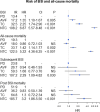Risk of death after first-time blood stream infection in incident dialysis patients with specific consideration on vascular access and comorbidity
- PMID: 30572826
- PMCID: PMC6302499
- DOI: 10.1186/s12879-018-3594-7
Risk of death after first-time blood stream infection in incident dialysis patients with specific consideration on vascular access and comorbidity
Abstract
Background: The mortality following blood stream infection (BSI) and risk of subsequent BSI in relation to dialysis modality, vascular access, and other potential risk factors has received relatively little attention. Consequently, we assessed these matters in a retrospective cohort study, by use of the Danish nation-wide registries.
Methods: Patients more than 17 years of age, who initiated dialysis between 1.1.2010 and 1.1.2014, were grouped according to their dialysis modality and vascular access. Survival was modeled in time-dependent Cox proportional hazard analyses. Potential risk factors confined by a modified Charlson comorbidity index (MCCI), were subsequently assessed in stepwise selection models.
Results: At baseline, 764 patients received peritoneal dialysis (PD), and 434, 479, and 782 hemodialysis (HD) patients were dialyzed by use of arteriovenous fistulas (AVFs), tunneled catheters (TCs), and non-tunneled catheters (NTCs), respectively. We identified 1069 BSIs with an overall incidence rate of 17.7 episodes per 100 person years, and 216 BSIs occurred more than one time in the same patient. HRs of post BSI mortality relative to PD were 3.20 (95% CI 1.86-5.50; p < 0.001) with NTCs; whereas no associations were found for AVF and TC. The risk of subsequent BSIs was higher with NTCs [HR 2.29 (95% CI 1.09-4.82), p = 0.030], and no significant difference was found for AVF and TC, in relation to PD. There was an increased risk of both outcomes with TC relative to AVF [death: 1.57 (95% CI 1.07-2.29, P < 0.021); BSI: 1.78 (95% CI 1.13-2.83, P < 0.014], and risk of death was reduced in patients who changed to AVF after first-time BSI. The MCCI was significantly associated with the risk of subsequent BSI and post BSI death; however, only some of the variables contained in the index were found to be significant risk predictors when analyzed in the fitted model.
Conclusions: While NTC was the most predominant risk factor for subsequent BSI and post BSI mortality, AVF appeared protective.
Keywords: Blood stream infection; Dialysis; Dialysis modality; Risk factors; Vascular access.
Conflict of interest statement
Ethics approval and consent to participate
Retrospective, register-basted studies of anonymized data do not require ethical approval in Denmark. The current study was approved by the Danish Data Protection agency (Reg-84-2015) and the Danish Patient Safety Authority (No. 3–3013-1329/1). Consent to participate was not required in the current study. This was waivered by the Danish Data Protection Agency, as data was collected retrospectively by use of the Danish nationwide registries for scientific epidemiological research only, and as the collection of informed consent in this setting was impossible.
Consent for publication
Not applicable.
Competing interests
The authors declare that they have no competing interests.
Publisher’s Note
Springer Nature remains neutral with regard to jurisdictional claims in published maps and institutional affiliations.
Figures



References
MeSH terms
LinkOut - more resources
Full Text Sources
Medical

